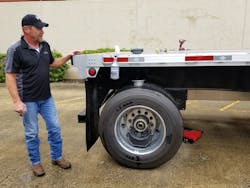Tire inflation technology boosts fleet efficiency
Maintaining proper tire pressure on commercial vehicles has always been important. However, with efficiency regulations and technology advancing at seemingly breakneck speeds the past decade or so, that importance is only increasing. Keeping tires at their recommended pressures not only helps to improve fuel efficiency, it can also increase the longevity of the tires themselves as well as related components. Additionally, with autonomous driving capabilities looming on the horizon, new technologies are needed to help fleets keep tabs on tire pressure at all times.
“As the industry thinks about [autonomous driving] technologies … these don’t even stand a chance of happening until we’ve firmly established how to monitor all of your tires,” says Dave Schaller, industry engagement director for the North American Council for Freight Efficiency (NACFE). “When the driver is not looking in the mirrors anymore, we need sensors and systems to control our tires so we know where the technology is going, it’s only going to be more crucial that we have [companies] like Meritor and PSI helping us get there.”
Pressure Systems International, commonly known as PSI, is one of the original manufacturers of automatic tire inflation systems (ATIS) for trailers according to Jim Sharkey, vice president of global sales and marketing for PSI. Since 1998, PSI has worked in collaboration with Meritor, selling the system as Meritor Tire Inflation System (MTIS).
That collaboration has led to success as, according to Sharkey, “about 70 percent of all for-hire and private fleets have selected MTIS as their preferred tire inflation system.”
The system works by using air from the trailer’s air supply tank, protected by a pressure protection valve to ensure brake systems always have air pressure. The pressurized air flows into the MTIS control box, which is set to the tires’ cold pressure setting. This regulated air then flows into the pressurized hollow axle tube, and to a rotary union at each wheel end. From there, hoses connect to each tire’s valve stem, maintaining proper inflation pressure.
MTIS can be specified from the factory on new trailers for most OEMs, or retrofitted onto trailers that don’t currently include the technology. Doug Dole, director of technical products and training for Meritor, says the company has partnered with Velociti, a provider of technology deployment and project management services, to offer aftermarket installation of MTIS. Dole says the retrofit can be completed on a trailer in about three to four hours.
Preventing thermal events
Another tire- and wheel-related issue many fleets see is thermal events caused by overheated wheel-ends. PSI created a solution to this issue with their ThermALERT system, which was made standard on MTIS in 2017.
“At the end of the trailer axle spindle is our end plug that keeps the pressure in the axle itself,” PSI’s Sharkey explains. “At the 12 o’clock position, [there is] a small thermal screw that has been hollowed out and filled with a eutectic metal. That eutectic metal is designed to melt at a very defined temperature, typically about 100 degrees [F] above normal wheel end operating temperature. At that temperature, pretty much all bets are off - you want to get that vehicle off the road. That center core will melt and allow the air pressure from inside the axle to escape, flow through the hubcap in a vent system, and create a loud audible whistle.
“When that happens, back in the control box there’s a flow sensing switch that will complete a circuit which turns on the tire indicator light,” he continues. “Anytime that light comes on the driver should be pulling over to determine whether or not you have a tire issue of some type, or whether you have a wheel end thermal event. If it’s a wheel end thermal event, you’ll be able to tell because typically that wheel is very hot, and air is escaping at a very high rate that creates that loud, audible screeching.”
Sharkey notes that if the driver stops when alerted, the wheel end should be able to be repaired instead of needing a total rebuild or complete replacement.
Communicating tire information
While MTIS is contained to the trailer, communicating with the driver via a light mounted at the front of the trailer where it is easily visible to the driver, Sharkey confirms that PSI is working with telematics companies such as Spireon, Phillips Connect Technologies, and Truck-Lite to enable remote monitoring.
In fact, Truck-Lite has announced integration of the PSI system into their Road Ready network, which communicates trailer data to fleets. Truck-Lite’s SmartBridge Integrator (SBI) bridges OE trailer systems with the Road Ready network. SBI will allow the PSI system to integrate with with Road Ready, communicating tire and wheel end data to fleets remotely.
“Our ATIS and TPMS solutions allow fleets to improve uptime and lower CSA scores while simultaneously allowing the driver to focus on driving and optimizing their hours of service,” says Jonathan Gravell, vice president of business development for PSI. “Integrating PSI systems into Road Ready helps fleets to drive down operating costs and diagnose issues before they become real problems.”
About the Author
David Brierley
Editor | Fleet Maintenance
David Brierley is a former editor of Fleet Maintenance magazine.
Brierley’s education and career have been based in the publishing industry. He is an award-winning writer and comes from a background in automotive, trucking, and heavy equipment. Brierley joined the Endeavor Business Media vehicle repair group in 2017 as managing editor for Fleet Maintenance, PTEN, and Professional Distributor magazines, as well as VehicleServicePros.com. In his current role, he writes for and oversees production of Fleet Maintenance magazine. He has worked in the publishing industry since 2011.

